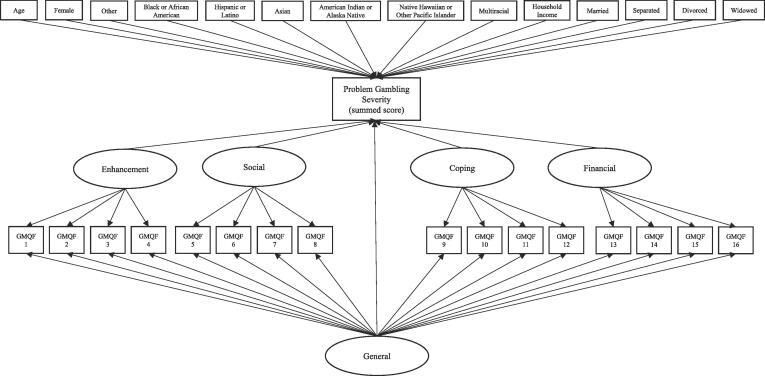彩票忠诚计划参与者赌博动机问卷的维度与效度。
IF 2.8
Q1 Psychology
引用次数: 0
摘要
目的:赌博动机问卷-金融(GMQ-F)测量四种赌博动机,这些重叠的结构可能是不同的,但也代表了一个整体的赌博动机。因此,本研究通过测试多因素模型配置来检验量表的因素结构,然后分析这些结构与问题赌博评估之间的关系。方法:对来自美国中西部某州彩票忠诚计划的数据进行分析(n = 6847)。GMQ-F的维度采用验证性因子分析(CFAs)比较三种不同的模型进行测试。使用结构方程模型(SEM)来评估赌博动机之间的关联,使用cfa中最佳拟合模型和问题赌博严重程度指数(PGSI)测量的问题赌博严重程度。结果:双因素指标显示多元性有限,大部分方差由整体博彩动机解释,有限方差由除金融动机外的特定动机解释。在扫描电镜中,一般动机与较高的PGSI分数相关。社交动机与较低的PGSI得分相关,而应对动机与较高的PGSI得分相关。增强和经济动机与PGSI分数没有关联。结论:我们的研究结果支持GMQ-F作为衡量赌博动机的工具的价值,但需要注意的是,动机类型或子量表是高度相关的。未来的研究应该探索经济收益作为赌博的一个独特动机。本文章由计算机程序翻译,如有差异,请以英文原文为准。

Dimensionality and validity of the Gambling Motives Questionnaire – Financial among lottery loyalty program participants
Objective
The Gambling Motives Questionnaire-Financial (GMQ-F) measures four gambling motives and these overlapping constructs may be distinct but also represent an overall gambling motivation. Thus, this study examined the scale’s factor structure by testing multiple-factor model configurations and then analyzing the association between these constructs and a problem gambling assessment.
Methods
Data from a lottery loyalty program in a Midwestern state in the United States were analyzed (n = 6847). The dimensionality of the GMQ-F was tested using confirmatory factor analyses (CFAs) comparing three different models. A structural equation model (SEM) was used to assess the association between gambling motives using the best fitting model in the CFAs and problem gambling severity measured by the Problem Gambling Severity Index (PGSI).
Results
Bifactor indices suggested limited multidimensionality with most of the variance explained by overall gambling motives, and limited variances explained by specific motives except financial motives. In the SEM, general motives were associated with a higher PGSI score. Social motives were associated with a lower PGSI score, while coping motives were associated with a higher score. Enhancement and financial motives showed no associations with PGSI scores.
Conclusions
Our findings support the value of the GMQ-F as an instrument for measuring gambling motivation, with the caveat that the types of motivations or subscales are highly correlated. Future research should explore the financial gain as a distinct motivation for gambling.
求助全文
通过发布文献求助,成功后即可免费获取论文全文。
去求助
来源期刊

Addictive Behaviors Reports
Medicine-Psychiatry and Mental Health
CiteScore
6.80
自引率
0.00%
发文量
69
审稿时长
71 days
期刊介绍:
Addictive Behaviors Reports is an open-access and peer reviewed online-only journal offering an interdisciplinary forum for the publication of research in addictive behaviors. The journal accepts submissions that are scientifically sound on all forms of addictive behavior (alcohol, drugs, gambling, Internet, nicotine and technology) with a primary focus on behavioral and psychosocial research. The emphasis of the journal is primarily empirical. That is, sound experimental design combined with valid, reliable assessment and evaluation procedures are a requisite for acceptance. We are particularly interested in ''non-traditional'', innovative and empirically oriented research such as negative/null data papers, replication studies, case reports on novel treatments, and cross-cultural research. Studies that might encourage new lines of inquiry as well as scholarly commentaries on topical issues, systematic reviews, and mini reviews are also very much encouraged. We also welcome multimedia submissions that incorporate video or audio components to better display methodology or findings.
 求助内容:
求助内容: 应助结果提醒方式:
应助结果提醒方式:


